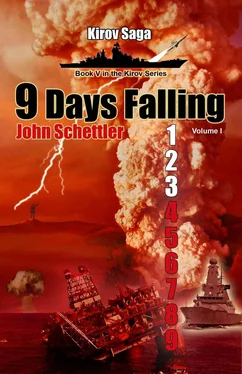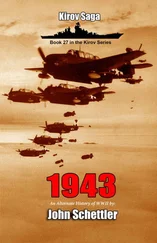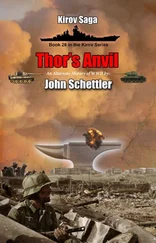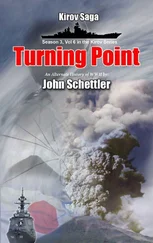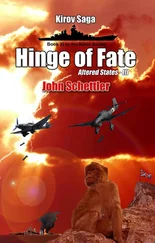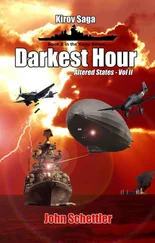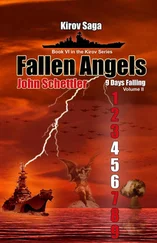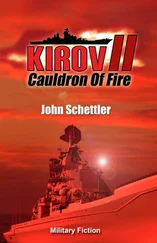~ ~ ~
Guamsat in the middle of the vast Pacific ocean like a big New York strip steak. The fat end of the steak was in the south of the thirty kilometer long island, where Naval Base Guam established facilities for the Commander of Naval Region Marianas, and Submarine Squadron 15, with three Los Angeles Class subs in attendance. The bay was empty that morning, as all three boats were out to sea, heading north at high speed now to screen the advance of CVBG Washington . South of the harbor was the big Joint Region Marianas Ordnance Annex, where both conventional and nuclear weapons were stockpiled for the navy. It was one of two large depots in the island. The narrower strip of the steak in the north was the site of Anderson AFB and the base munitions storage area where tons of ordnance were stored in a wide area of underground bunkers. Just west of this area was the Naval Computer and Telecommunications Station, with the Marlock 25 meter satellite tracking antenna.
The assets now being gathered on the island and its strategic location made it one of the most valuable US bases in the Pacific, perhaps second only to Pearl Harbor and Hawaii. As such it would soon become a rich target of opportunity for anyone wishing to wage war against the Americans. China had not yet fired on US territory in anger, their ASAT attack being deemed “defensive” in nature in the debates still raging in the UN. This thin rein of restraint still held the Chinese in check even as their missiles launched on Taiwan. But China had other wayward sons, and the volatile regime in North Korea was one of them, with the world’s fourth largest standing army snarling at the south across the DMZ.
North Korea would do the dirty work and launch the first blow, or so it had been planned. This would present the US with the impossible choice of having to attack North Korea and bring it into the war if they acted in reprisal. The nightmare scenario of having to defend Japan, South Korea and Taiwan at the same time was now becoming a dire reality.
Defense analyst Reed had argued that the US should take prompt preventative measures and destroy the Musudans on the launch pad before they could fire. “This deployment appears to be identical to the tests we observed earlier,” he said hotly. “If I’m correct, then we’ve got to get the damn things in their boost phase. Once they hit apogee it will be too late.”
“We still have THAAD out on Guam, Mister Reed,” Air Force General Lane replied. “The system is tried and true. We can get these missiles just as they tip into their descent phase.”
“And what if they explode before they tip over, general?” Reed gave the Air Force officer a wide eyed challenge. “What then?”
Lane eyed the feisty analyst, inwardly resenting a civilian trying to tell him how to do his job, but he realized what Reed was getting at. “You are suggesting this is an asymmetrical weapon?”
“Damn right I am! They still can’t hit the broad side of a barn from three feet away, but they can get a missile close enough to put some serious hurt on the assets at Guam. All it has to do is get up over the island and go kaboom.”
“I don’t understand,” said Rod Leyman, White House Chief of Staff. “What good will that do them, even with a nuclear bomb if they have one? Don’t they have to hit the island itself?”
“EMP,” Reed said flatly. “That’s what’s written all over this deployment, Mister Leyman, and General Lane here knows exactly what I’m talking about.”
“Electro Magnetic Pulse,” said Lane. “A high altitude explosion would have a fairly wide footprint.”
“Which is why you have to either get the missiles before they launch,” said Reed, “or else that footprint is going to stomp on every computer and electronic device on that island and you can write the whole place off as an effective operational military base.”
“We can put cruise missiles on that launch site in a heartbeat,” said General Lane. “I’ve got bones at Kadena on Okinawa, B-1 bombers. They’re ready on the Tarmac now.”
“Then what are you waiting for?” Reed argued.
“He’s waiting because the President has yet to make the decision to strike the first blow here, Mister Reed. To do so we will have to make a direct military attack on a regime in North Korea wound up tighter than a coiled spring. We already have a hornet’s nest on our hands in Taiwan. All we need is for a million North Koreans to come surging over the border into the Seoul, right?”
Then word came in that the North Koreans had already fired Musudan I and the tension in the room was palpable. As the minutes passed, Reed shifted uncomfortably in his chair, tapping his pen on a notepad in front of him. They were too late, or so he thought. The missile was going to explode at high altitude and send a violent EMP burst through the atmosphere that would knock the base off the operational list for the foreseeable future, but this time he was proved wrong. The US had picked up the launch by satellite, tracked it through the ascent phase and then keyed assets to intercept as it passed through apogee and began its terminal descent.
The Musudan tipped over and it was soon bait for the very capable ABM systems the US had deployed on the island for just this contingency. Alpha Battery, 4th Air Defense Artillery Regiment on Guam was given the order to fire, and it sent up two THAAD missiles using the “hit-to-kill” strategy to destroy the incoming Musudan by kinetic impact.
The first shot was an easy kill for the advanced US ABM system, and the rhetoric that accompanied the attack would end up being far worse than the event itself. North Korean media announced that the US and its allies were “waging madcap war maneuvers against it to plan a pre-emptive nuclear strike.” They were not too far off the mark with that one, because there were two rockets positioned on the east coast of North Korea, and defense analyst Reed and others like him now believed they knew what the second missile housed in its red tipped nose.
Musudan II was indeed carrying an EMP super-bomb, technology the North Koreans had obtained from the Russians years ago through espionage. Their first shot was just target practice to test US defenses as much as anything else. By watching the destruction of the first missile, the North Korean military could reap the political harvest while also determining the approximate altitude of the kill so they could set their warhead to explode well before the US ABM system could do its job. It would raise the altitude of their intended detonation, and also increase the lethal footprint of the effects on the earth below. If Musudan II fired as planned, and did its intended job, there wouldn’t be a silicon circuit worth the name functional on Guam and surrounding areas for hundreds of miles.
An hour later Musudan II fired as planned.
Reed was still in the situation room when it happened, now permanent staff there to keep his well educated iron in the fires of the heated debate. He was stewing because General Lane had given him that ‘I told ya so’ smirk when THAAD took down the first missile without any trouble.
“Have a little faith, Mister Reed,” he had admonished. “We know what we’re doing here.”
“Right,” said Reed. “Well don’t be surprised if this one explodes at apogee.”
“It’s not ever going to get there,” said Lane, cool and unruffled. “We have a few more surprises in store for Mister Kim Jong-Un.”
The B-1s on Kadena were not the only bones the Air Force had dug up from the boneyards. They had pulled something out of the hangers at 309th Aerospace Maintenance and Regeneration Group, Davis-Monthan Air Force Base, Tucson, Arizona. It was called YAL-1, formerly known as the Airborne Laser Project, a prototype aircraft from a program cancelled years ago because of its expense. The Air Force had been secretly preparing to test it in a live scenario like this, secretly moving it into the Pacific. It was up early that morning from Kadena, escorted by a pair of F-22 Raptors .
Читать дальше
